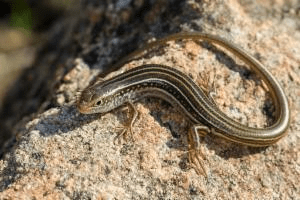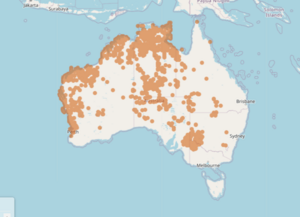Ctenotus inornatus facts for kids
Quick facts for kids Ctenotus inornatus |
|
|---|---|
 |
|
| Conservation status | |
| Scientific classification | |
| Genus: |
Ctenotus
|
| Species: |
inornatus
|
 |
|
The bar-shouldered ctenotus (Ctenotus inornatus) is a type of skink, which is a kind of lizard. You can find this skink in many parts of Australia, including the Northern Territory, Queensland, Victoria, New South Wales, and Western Australia.
Contents
About the Bar-Shouldered Ctenotus
The bar-shouldered ctenotus is part of a special group of skinks called the Ctenotus inornatus group. These skinks are quite large, usually growing to be about 8.5 to 11 centimeters long from their nose to the start of their tail. They all share similar colors and patterns, making them a unique group of reptiles.
Cool Features
These skinks have interesting color patterns, often a mix of stripes and spots. Their toes are not very flat, and they have special pads on the underside of their toes. These pads might help them move around easily in their habitat.
They also have unique scales above their eyes, called supraciliary scales. The first three of these scales are bigger than the others. This helps scientists tell them apart from other skinks.
How They Look Different
One way to tell a bar-shouldered ctenotus apart is that it doesn't have a white stripe under its eye. Also, the patterns on its back usually don't reach far onto its head or neck.
Sometimes, even within the same species, their patterns can change. For example, in some parts of Western Australia, like the Murchison and Gascoyne areas, and the northern Kimberley region, the patterns on their backs might be less clear. However, the patterns on their sides often stay very noticeable. This shows how diverse these skinks can be!
Naming and Family Tree
John Edward Gray first gave the bar-shouldered ctenotus its scientific name, Ctenotus inornatus, in 1845. The Ctenotus group of lizards is very large. It includes over 100 different types of skinks. This makes it one of the biggest groups of backboned animals in Australia.
Other Names for This Skink
Sometimes, a species can have different scientific names over time. These are called synonyms. Here are some other names that have been used for this skink:
- Ctenotus inornatus (Gray 1845)
- Ctenotus helenae (Storr, 1969)
- Ctenotus severus (Storr, 1969)
- Ctenotus saxatilis (Storr, 1970)
- Ctenotus brachyonyx (Storr 1971)
- Ctenotus fallens (Storr 1974)
Where They Live
The bar-shouldered ctenotus shows many different color patterns depending on where it lives. This can sometimes make it tricky to tell them apart from other Ctenotus species that live in the same areas. However, adult bar-shouldered ctenotus usually have distinct patterns.
Northern and Central Australia
In the northern parts of Australia and across the central deserts, these skinks often have very faint patterns. In the Pilbara region, they are usually brown with light stripes. Some might only have a faint dark stripe down their back, while others have almost no pattern at all. In the northern Great Sandy Desert and Tanami Desert, they are often unpatterned. These patterns are different from other skinks like C. robustus and C. superciliaris, which have strong patterns in these areas.
Southeastern Australia
In southeastern Australia, the bar-shouldered ctenotus can sometimes be confused with C. spaldingi. Here's how to tell them apart:
- Bar-shouldered ctenotus: Their face usually has no patterns or stripes. The area between their front legs and ear opening is also unpatterned. Their legs are generally plain. Stripes on their back do not extend onto their neck. They often have a bold black stripe down their back.
- Spalding's ctenotus (C. spaldingi): These skinks usually have at least a partial stripe under their eye and dark stripes on their lips. Their back patterns are usually strong, with stripes extending onto their neck. Patterns on their sides also extend past their front legs. Their legs tend to have streaks.
Life in the Desert
The bar-shouldered ctenotus is well-suited to living in the deserts of Australia. They especially like areas with lots of spinifex grass. They often move around inside or along the edges of these thick grass clumps. This helps them find food and stay hidden from predators.
What They Eat
These skinks eat many different things, showing how adaptable they are. Their main food is termites. They also eat ants, locusts, beetles, other insects, and sometimes even parts of plants. This varied diet helps them survive in the dry desert environment.
Making More Skinks
The bar-shouldered ctenotus lays eggs during the Australian spring and early summer, from October to February. They usually lay up to six eggs in a clutch.
Male skinks are ready to reproduce in October and November. Female skinks have two main times for producing eggs: in spring (September to November) and in summer (January and February). It's possible for a female skink to lay more than one clutch of eggs in a single season!


